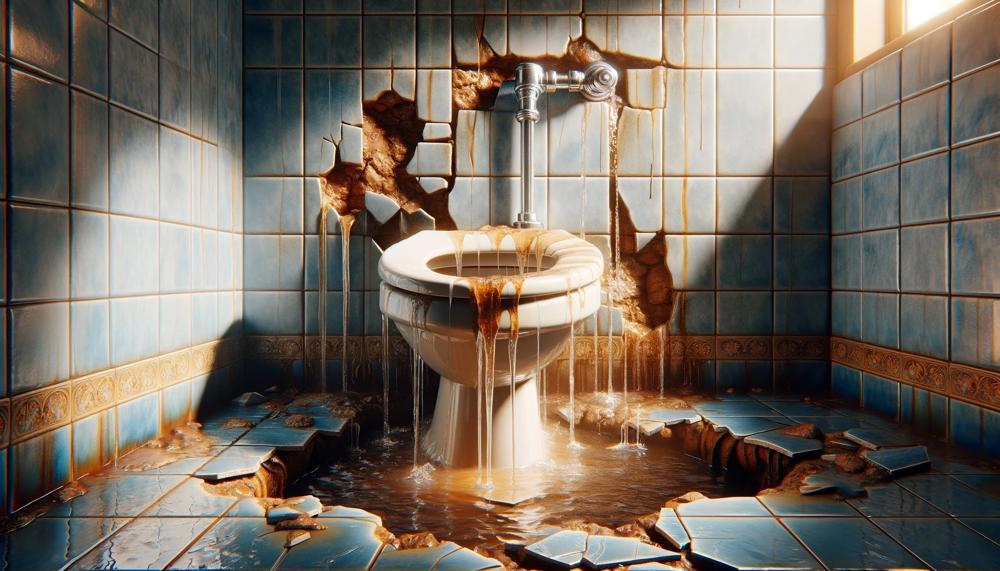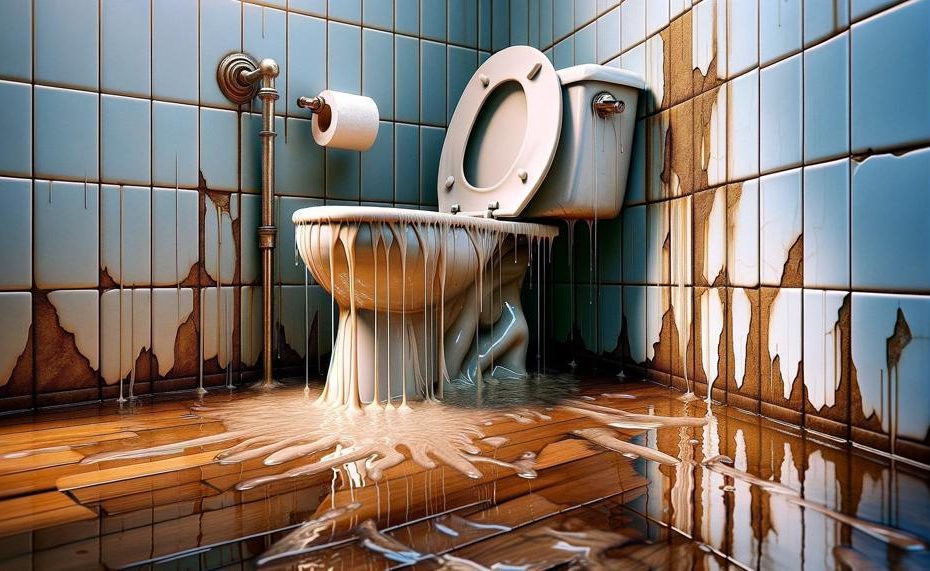Are you tired of tiptoeing around your bathroom, avoiding the sopping wet floor? Do you find yourself constantly battling stubborn water stains and musty odors in your bathroom? If so, it’s time to face a potential hidden issue – a leaking toilet under your tile.
So, can toilet leak under tile?
Yes, a toilet can leak under tiles. Here are some signs that your toilet may be leaking:
- Running water: You may hear running water when the toilet isn’t on, which can help you detect a leak.
- Brown stains: A brown or yellow stain around the base of your toilet may indicate a leak.
- Damp area: There may be a damp area on the floor around the bottom of the toilet.
- Spongy floor: The floor around the toilet may feel spongy or springy.
In this blog post, we’ll explore the signs of a possible leak, its underlying causes, and what measures you can take to prevent or address this problem.
Get ready to delve into the world of hidden plumbing issues – because it’s time to discuss toilets that leak under tile.
Contents
- 1 Why Checking for a Leaking Toilet is Important
- 2 Signs Your Toilet Might Be Leaking Under the Tile
- 3 How to Detect a Leaking Toilet in the Initial Stage
- 4 Steps to Pinpoint the Location of the Leak
- 5 Fixing Leaks Under Tile Toilets: DIY or Hire a Professional?
- 6 Preventing Toilet Leaks Under Tile: Tips and Tricks
- 7 Maintaining a Leak-free Toilet Under the Tile
- 8 Conclusion
Why Checking for a Leaking Toilet is Important
A leaking toilet hidden under your tiles can have a significant impact on the overall well-being and safety of your home. Here are some ways that a leak can affect your home:
- Water damage: Neglecting a leaking toilet can lead to water seeping into your floors and walls, causing extensive water damage. This not only weakens the structural integrity of your home but also creates an ideal environment for mold to thrive.
- Mold growth: The moisture from a leaking toilet creates the perfect breeding ground for mold. Mold can cause a multitude of health problems, ranging from respiratory issues to allergies, and in severe cases, even neurological problems.
- Slip and fall hazards: A leaky toilet can result in water pooling on the floor, posing a slip and fall hazard. This becomes especially hazardous when the leak is not immediately noticeable, catching people off guard.
- Higher water bills: A leaking toilet can waste a significant amount of water, resulting in higher water bills. This not only impacts your finances but also contributes to larger environmental issues such as water scarcity.
- Structural damage: As time passes, water damage caused by a leaking toilet can weaken the very foundation of your home, leading to cracks and other costly issues that require repairs.
Signs Your Toilet Might Be Leaking Under the Tile
If you have a sneaking suspicion that your toilet may be leaking underneath the tile, there are a few telltale signs to keep an eye out for. These signs include:
- Areas of dampness or wetness on the floor surrounding the base of the toilet
- A musty or unpleasant smell emanating from your bathroom
- Tile that is loose, cracked, or discolored
- Water stains on the ceiling directly below the bathroom
- An unexplained increase in your water bill despite no noticeable changes in usage
These signs could be indicators of a leak in your toilet that is seeping water beneath the tile. Ignoring a leaking toilet can result in severe damage and costly repairs, so it’s crucial to address the issue promptly.
How to Detect a Leaking Toilet in the Initial Stage
In order to detect a leaking toilet in its early stages, it’s important to keep an eye out for these common signs:
Water pooling at the base of the toilet
If you see water pooling around the base of your toilet, it’s a clear indication of a leak.
This could be caused by a faulty wax ring or loose bolts, allowing water to seep out.
Dampness or discoloration on the bathroom floor
Aside from visible water, you may also notice dampness or discoloration on the floor near the toilet.
This is an early sign of a leak and should be addressed promptly to prevent further damage.
Musty odor in the bathroom
Leaks under your bathroom tiles can create a dark and damp environment, perfect for mold growth.
A musty odor in your bathroom could be a sign of a hidden leak.
Changes in water bill
A leaking toilet means water is constantly running and being wasted, resulting in a higher water bill even if you’re not using more water than usual.
Toilet movement or shifting
If your toilet moves or shifts when you sit on it, this could indicate an underlying issue such as a leak.
It’s important to address this immediately to prevent further damage.
Visible cracks or damage to the toilet
Over time, toilets can develop cracks or other types of damage that can lead to leaks. It’s important to regularly inspect your toilet for any visible damage and address it promptly.
Fluctuations in water level in the bowl
If you notice that the water level in your toilet bowl is constantly changing, this could be a sign of a leak. The water level should remain consistent unless the toilet is being used.
In summary, it’s crucial to be attentive and watch for these common signs when trying to detect a leaking toilet in its early stages. By catching a leak early on, you can prevent further damage and avoid costly repairs in the future.
Steps to Pinpoint the Location of the Leak
Steps to Pinpoint the Location of the Leak:
- Look for Indicators of Water Damage: The first step to locating a leak under tile in your toilet is to observe any signs of water damage. This may involve noticing water pooling around the toilet’s base, signs of dampness or discoloration on the floor, musty odors, changes in your water bill, movement or shifting of the toilet, visible cracks or damage on the toilet, and fluctuations in the water level of the bowl.
- Absorb Water and Wait for More: If there is visible water present, use a sponge to soak it up and then wait for more to appear. This will confirm that the leak is indeed coming from under the toilet.
- Tighten Bolts: If the leak is minor and originating from the base of the toilet, try tightening the bolts that hold the toilet in place with a wrench.
- Replace Wax Gasket: If tightening the bolts does not solve the problem, you may need to remove the toilet and replace the wax gasket between it and the closet flange. This can be done by disconnecting the water supply line, unscrewing the nuts on the bolts at the base of the toilet, and lifting it off.
- Inspect Flange Condition: Before installing a new wax gasket, check the condition of the flange. It should be flat and not cracked or bent. If it appears damaged, consider using a Gapper Flange Repair Strap to fix it before proceeding.
- Install New Wax Gasket: Place the new wax gasket centered on top of the closet flange for a watertight seal.
- Replace Supply Tube: While you have removed the toilet, consider replacing the supply tube as well. Using a flexible stainless steel-enmeshed polymer tube instead of an old chrome-plated copper one can provide added durability.
- Reinstall Toilet: Set the toilet back in place, ensuring it is properly aligned with the flange. Tighten the bolts and cut them flush with the nuts before covering with caps.
- Caulk Around Base (optional): Depending on building codes in your area, it may be necessary to caulk around the base of the toilet to prevent bacterial growth in joints. This step is optional but can provide added protection against leaks.
- Test for Leaks: After everything is reinstalled, flush the toilet several times and check for any signs of leaks. If necessary, retighten bolts after a few weeks of use to ensure a proper seal.
By following these steps, you should be able to successfully locate and repair a toilet leak under tile without the need for professional assistance.
Fixing Leaks Under Tile Toilets: DIY or Hire a Professional?
When faced with a leak under a tile toilet, it’s crucial to evaluate the severity of the leak and your own abilities before deciding to either tackle the repair yourself or hire a professional. Depending on the damage, it may be more beneficial to leave the job to an experienced plumber.
DIY Steps for Fixing Leaks Under Tile Toilets
- Assess water damage: Prior to attempting any repairs, thoroughly examine the surrounding area for any signs of water damage. If there is significant damage, it is best to seek professional assistance.
- Tighten bolts: If the leak appears to be originating from the base of the toilet, try tightening the bolts that secure it to the floor. However, use caution to avoid over-tightening and potentially cracking the porcelain.
- Inspect wax seal: If tightening the bolts does not resolve the issue, it may be necessary to replace the wax seal between the toilet and drain pipe.
- Shut off water supply: Before replacing any parts, ensure that the water supply to the toilet is turned off.
- Remove toilet: In order to replace the wax seal or other plumbing components, you will need to remove the toilet. Follow proper techniques and handle the heavy porcelain carefully.
- Replace wax seal: Carefully remove the old wax seal and replace it with a new one, ensuring that it is centered and secure.
- Test for leaks: After replacing any parts, turn on the water supply and flush the toilet to check for any remaining leaks. If there are still leaks present, double check all connections and replace any damaged parts.
- Inspect tile and grout: In cases where there are no apparent cracks in the toilet or plumbing, inspect the tile and grout for any cracks or gaps that could potentially allow water seepage.
- Repair damaged tile or grout: If any cracks or gaps are found, it will be necessary to replace the damaged tile or re-grout the area.
- Reinstall toilet: Once all repairs have been completed, carefully reinstall the toilet and perform a final check for leaks.
Hiring a Professional
If you do not feel confident in your ability to complete any of these DIY steps or if the leak is significant, it may be best to seek professional assistance from a plumber. They possess the necessary expertise and tools to efficiently and effectively fix leaks under tile toilets.
Additionally, they can also identify and address any other potential issues that may be contributing to the leak.
Preventing Toilet Leaks Under Tile: Tips and Tricks
To ensure your tiled bathroom floor remains free from toilet leaks, make sure to take these necessary steps:
Proper installation is key
A crucial first step is to ensure that your toilet is correctly installed on the tiled floor, without any gaps or uneven surfaces around the base.
This will prevent water from seeping through and causing damage.
Don’t overlook regular maintenance
Regularly check for any cracks or damage in the grout and repair them promptly.
This will help maintain a waterproof barrier and prevent water from seeping under the tiles.
Consider investing in a toilet leak detector
For added peace of mind, it’s worth investing in a toilet leak detector. This device can detect even small leaks that may not be visible to the naked eye.
Don’t delay addressing leaks
If you spot any water around the base of your toilet, don’t delay addressing it. The longer you wait, the more damage can occur. Call a professional plumber to inspect and repair the issue immediately.

Be aware of other potential causes
It’s essential to pay attention to loose tank bolts, cracked wax rings, damaged gaskets, or faulty O-rings that may cause leaks in different parts of the toilet.
Use food coloring as a simple leak detector
To detect even small leaks, add a few drops of food coloring into the tank. If you see colored water seeping into the bowl without flushing, it’s a sign of a leak.
By following these tips and tricks, you can effectively prevent toilet leaks from occurring under tile and avoid potential water damage and costly repairs in the future.
Maintaining a Leak-free Toilet Under the Tile
Maintaining a leak-free toilet under tile is crucial to prevent costly repairs and water damage in your bathroom. To avoid toilet leaks, make sure to have it installed by a professional plumber or follow the manufacturer’s instructions meticulously. Regular maintenance, such as checking for cracks or leaks and replacing worn-out parts, can also help prevent leaks.
If there is a leak under your bathroom tile, it is vital to address it promptly to prevent further damage. Here are the steps you can take to fix a toilet leak under tile:
- Inspect the tile closely: Look for any breaks or cracks in the tile that may be causing the leak.
- Remove the tile and grout: Use a grout saw or utility knife to remove the damaged tile and surrounding grout.
- Fix the leak: Once you have identified the source of the leak, repair it using appropriate materials like plumber’s putty or silicone caulk.
- Repair the surface: If the leak has caused damage to the surface beneath the tile, fix it before replacing the tile.
- Replace the tile: Apply adhesive or thinset to the back of the new tile and firmly press it into place. Use spacers to maintain even spacing between tiles.
By following these measures and regularly maintaining your toilet, you can effectively prevent and fix toilet leaks under tile in your bathroom. Additionally, investing in a leak detector can help you detect leaks early on and prevent extensive damage.
Remember, you can use food coloring as an easy detector by adding a few drops into the toilet tank and checking for any color in the bowl after 15 minutes.
Conclusion
In conclusion, the seemingly minor inconvenience of a leaking toilet hidden under bathroom tiles can quickly turn into a major problem if left untreated. Not only can it cause significant damage to your home, but it can also lead to costly repairs. To avoid these issues, it’s crucial to be aware of the signs of a leaking toilet and take immediate action.
From dampness on the floor to musty odors and increased water bills, there are several red flags that may indicate a leak. Don’t ignore them – address the issue promptly by either fixing it yourself or hiring a professional plumber. Remember, time is of the essence when dealing with a leaking toilet under tile.
Additionally, regular maintenance and proper installation can go a long way in preventing toilet leaks from occurring in the first place. Don’t underestimate the importance of taking care of your plumbing system.
Keep in mind that even small leaks can have big consequences – from mold growth to compromising your flooring’s structural integrity. Don’t let an unnoticed leaking toilet wreak havoc on your home.





